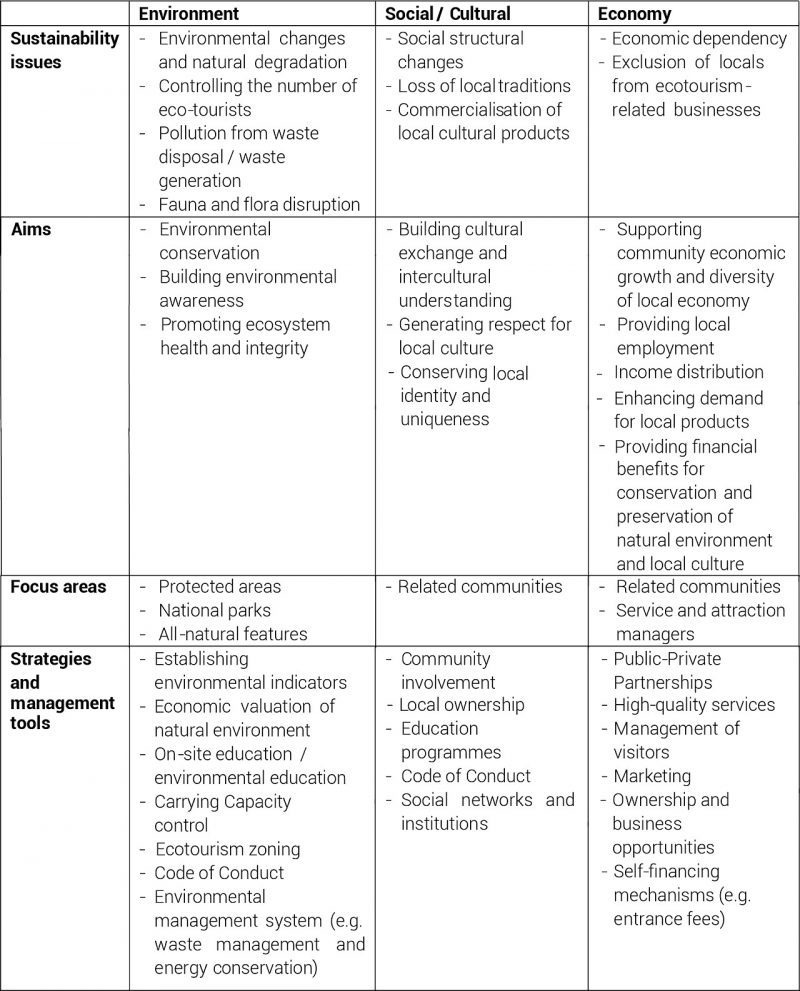Executive Summary
- Ecotourism is a market-based approach to environmental conservation and sustainability that provides economic gains and incentives for local communities to aim towards preserving and protecting their natural resources
- Towards that end, their involvement in policy-making, planning and management of the ecotourism affecting them is vital
- Ecotourism being multidimensional in nature, efficient planning can be achieved by pooling together the required resources, knowledge and expertise of various stakeholders, including the government, enterprises, tourists, and local community members
Introduction
Sustainable tourism as defined by the World Tourism Organization “takes full account of its current and future economic, social and environmental impacts, addressing the needs of visitors, the industry, the environment and host communities”. Striking a balance between the three dimensions, while still leaving room for developmental growth, is essential to the industry’s long-term viability.
The management and conservation of environmental resources are important both to the future of the tourism sector and to society as a whole. But if not properly handled, tourist presence is very much liable to bring lasting detrimental impacts on the environment, the economy, and the local communities’ social structures and cultures. The boost in the country’s economy and local income notwithstanding, uncontrolled and irresponsible mass tourism can result in pollution, high consumption of energy and water, soil erosion, changes in wildlife behaviour, and waste generation – all of which can be very serious threats to the natural environment.[1]
Tourism activities involving relatively intense interactions between tourists and local cultures are equally likely to negatively affect the socio-cultural structure of the host community. Hence, promoting a sustainable approach and developing responsible tourism policies must be prioritised and executed.
Ecotourism, or nature-based tourism, refers to “responsible travel to natural areas that conserves the environment, sustains the well-being of the local people, and involves interpretation and education”.[2] It is an effective tool for sustainable tourism development which assists in conserving natural assets, maintaining sustainable use of resources, and protecting human cultures.
It provides an alternate source of livelihood for local communities, contributing to their respective developments. More importantly, ecotourism has the ability to generate employment – both directly in the tourism sector and indirectly through various support and resource management sectors – and additional income, especially in rural areas. In fact, the reasoning behind this form of travel is the safeguarding of local tourism businesses and the protection of natural resources.
Tourism in Penang and more broadly, in Malaysia is one of the fastest growing industries in the services sector and a key pillar in generating remarkable economic income. Its rapid development has been encouraging the government to actively pursue a range of new products ever since the Malaysian Tourism Policy was formulated back in 1992. Under this policy, ecotourism was identified as a form of tourism to be prioritised and expanded. The more detailed National Ecotourism Plan (1996) soon followed, as did the subsequent National Ecotourism Plan (2016-2025) that provides a general framework for the developing and harnessing of the country’s ecotourism potential.
Penang is one of Malaysia’s many green lungs, owing to its unique ecosystem and biodiverse flora and fauna. However, addressing concerns about sustainability, the protection of natural resources and the involvement of local communities, has become increasingly challenging to date.
Ecotourism potential in Penang
Penang’s ecotourism shows great promise in becoming a flourishing economic industry and in delivering ecologically sustainable development to the state. Penang, both the island and Seberang Perai, houses many ecotourism attractions such as the Penang National Park and its meromictic lake, Penang Hill, the Tropical Spice Garden and Botanic Gardens, as well as numerous permanent forest reserves, catchment areas, river bank areas, mangrove forests, fruit gardens and beaches.
It has vast educational potential as well. Turtle- and bird-watching are excellent examples of how ecotourism – through the involvement of local guides – is able to raise awareness for habitat protection, leading to long-term conservation of endangered species. Additionally, ecotourism activities in Penang have generated job opportunities for nature guides, boatmen, managers and researchers; and indirectly created jobs through tourist demands for accommodation, food, transportation and souvenirs.
Homestays, for example, are a popular rural ecotourism activity for tourists to immerse themselves in the lives of the locals and to experience their day-to-day activities. In 2018 the total number of homestay tourist arrivals and the total income from homestays in Penang were recorded to be about 4,512 and RM401,117, respectively.[3]
According to a survey conducted by Penang Global Tourism in 2017, about 23.9% of visitors listed visiting national parks, hiking and trekking as high-priority activities to do in Penang. Penang’s primary ecotourism attraction, however, is its forested areas. Approximately 78% of total forested land areas in the state are known as Permanent Reserved Forests (PRFs), which are managed based on sustainable forest management principles and practices.[4] The remaining forested areas fall under wildlife reserves and state land forests, which are subject to becoming future reservations. These areas can in fact provide Penang with a sustainable source of income, especially for the local communities.
Ecotourism in Penang can be incorporated into other forms of tourism as well, including agro-tourism, cultural tourism and adventure tourism. For example, the agro-tourism industry can expose tourists to the culture and traditions of rural communities. Farms and plantations, harvesting, husbandries, herbs and spices, paddy fields, oil palm as well as aquaculture can be packaged as agro-tourist attractions; and fruit-plucking, paddy-planting and fish- and livestock-feeding as must-do tourist activities.
A framework for ecotourism development in Penang
Despite the many advantages that can be gained through achieving sustainable tourism development, there is still a notable gap between the theory and practice of ecotourism on the ground, e.g. what works in one place does not indicate equal success in another. Each area and region has its own unique characteristics. Hence, the implementation of ecotourism should be based on social and cultural norms, and give full consideration to the habitats and environs of the specific area.
A proposed framework for ecotourism development and policy thinking in Penang is presented in Table 1. The main components include the environment, and socio-cultural and economic aspects. Balance between these dimensions is essential for responsible tourism development.
Table 1: Proposed ecotourism planning framework and tools for Penang
The environmental dimension
Ideally, ecotourism in Penang should aim towards conserving the natural environment, building environmental awareness and promoting ecosystem health. Without effective environmental management, ecotourism development is futile. Therefore, there is the need to establish a set of environmental management indicators to monitor changes occurring at tourist sites. These indicators can then be used to measure and improve the ecotourism quality of the state.
For ecotourism to result in environmental conservation, the social and economic values of natural goods and services need to be estimated, and the information shared with the communities to strengthen their understanding of the sector, e.g. through surveys or experiments where people reveal their values for the benefits derived from environmental goods and services through their willingness to pay (WTP) for those benefits; or in the case of environmental loss, reveal their values through their willingness to accept (WTA) compensation to tolerate the loss.[5] WTP and WTA can be applied to improve environmental quality as well as economic growth.
In addition, a Code of Conduct (COC) and capacities in environmental management and conservation should be developed for all stakeholders. This can be strengthened by on-site education and training. Education enhances the environmental knowledge of tourists and improves visitors’ behaviour, but the number of tourists and activities at ecotourism sites still needs to be regulated. The notion of Carrying Capacity (CC) can be applied to estimate the appropriate number of eco-tourists and services that can be supported in specific areas and at certain times.[6] As part of the visitor management process, zoning and mapping are also useful tools in gauging the optimum use of an area based on its environmental capabilities.[7]
The socio-cultural dimension
The local communities are a pivotal element at an ecotourism attraction, holding the potential to provide visitors with first-hand knowledge of their cultural heritage and overall tourism resources. But to ensure the continued well-being of the locals and the conservation of their culture, and to prevent the destruction of their traditional resources, it is vital that the communities be included in the drafting of conservation strategies and the ecotourism development process.
In fact, direct involvement of the communities in resource management – facilitated by social networks and institutions – allows for a clear and unified understanding of their collective responsibilities. Likewise, COC, environmental awareness and education programmes should be tailored for the communities to approach developing and sustaining Penang’s ecotourism more holistically, and at the same time address the negative impacts it may have on them.
The economic dimension
Ecotourism-related income, e.g. entry fees and other charges levied on visitors, sales of services and products at the site, donations, and other indirect sources such as accommodation, food and tours, should provide economic returns to the local communities and ensure that the benefits are fairly shared.
Not only do locally-owned ecotourism businesses create job opportunities, especially for people from the rural communities, they also challenge locals to creatively develop exciting ecotourism experiences for tourists, as well as provide economic incentives through their involvement in nature conservation activities.
Responsible development of ecotourism products and self-financing mechanisms by establishing strategies on marketing, visitor management and collection fees, as well as developing management skills, advantageously contribute to the conservation and sustainable development of the tourist site, and the overall economics of ecotourism.
The quality of ecotourism services (transportation, food, guides, etc.) is also important in assuring tourists’ satisfaction. However, more detailed research in assessing the quality of ecotourism services provided in Penang is still needed.[8]
A public-private partnership (PPP) can pool together resources required to develop new ecotourism strategies and initiatives, managing ecotourism development, as well as joint investment in the sector. On the one hand, the government is unable to solely expand the industry as it does not operate businesses; while on the other, the private sector may require help with regulations, access to resources and funding.
The lack of experience and skills needed to manage and operate ecotourism products and services forces local communities to depend on tour companies to provide guidance and marketing, and to bring business to them. In such cases, third parties like PPPs can facilitate a sustainable business partnership by providing the opportunity for locals to access the market and offer tour companies the chance to invest in ecotourism tour programmes. This approach links and draws on the strengths of the local communities, the public sector and the private sector. It represents a pooling of knowledge, expertise, capital and other resources from different stakeholders.
Conclusion
When expertly managed, ecotourism comprises a dynamic relationship between tourism, biodiversity and local communities. In fact, a good ecotourism model should create sustainable quality tourism based on sound environmental management, active creation of conservation awareness, as well as responsible community involvement. If kept in line with a positive environmental ethic, ecotourism can generate its own preferred behaviour.
Collaboration and partnership are key elements in further developing Penang’s ecotourism. Multidimensional in nature, ecotourism needs cross-sectoral and multiple-stakeholder approaches to pool together the resources, knowledge and expertise of stakeholders from various sectors, including bodies such as the Department of Wildlife and National Parks (DWNP), the Penang State Forestry Department (JPNPP), the Ministry of Tourism, Arts and Culture (MoTAC), the Department of Environment (DOE), the Department of Agriculture (DOA), the Department of Fisheries (DOF), the Penang Island City Council (MBPP) and Seberang Perai Municipal Council (MPSP), Penang Global Tourism (PGT), travel and tourism companies, NGOs and local communities. The ecotourism plan should also be framed with expert consultation from international, national and local governing authorities.
[1] Abdullah, A. R., Weng, C. N., & Afif, I. (2018). Ecotourism in Penang National Park: A Multi-Stakeholder Perspective on
Environmental Issues. Journal of Business and Social Development, 6, 70-83.
[2] The International Ecotourism Society (TIES). (2015). Retrieved from: https://ecotourism.org/what-is-ecotourism/
[3] Ministry of Tourism, Arts and Culture Malaysia.
[4] Department of Statistics, Malaysia.
[5] Phillips, A. (1998). Economic Values of Protected Areas: Guidelines for Protected Area Managers, Task Force on Economic Benefits of Protected Areas of the WCPA of IUCN in Collaboration with the Economics Service Unit of IUCN.
[6] Chougule, B. (2011). Environmental carrying capacity and ecotourism development. International Journal of Economic Issues, 4(1), 45.
[7] Ohadi, S., Dorbeiki, M., & Bahmanpour, H. (2013). Ecotourism zoning in protected areas using GIS. Advances in Environmental Biology, 677-684.
[8] It is difficult to find accurate data on ecotourism, as there is no classification system. In fact, this is also a major challenge when it comes to monitoring and assessing the sector’s performance, as well as when developing better policy analysis and decision-making.
Managing Editor: Ooi Kee Beng, Editorial Team: Regina Hoo, Nur Fitriah, Ong Wooi Leng
You might also like:
![Cold War 2.0 Comes Knocking at ASEAN’s Door: Choices for ASEAN, China, and US]()
Cold War 2.0 Comes Knocking at ASEAN’s Door: Choices for ASEAN, China, and US
![Key Measures Identified for Strengthening STEM Interest among Students in Penang]()
Key Measures Identified for Strengthening STEM Interest among Students in Penang
![Obesity in Malaysia: Unhealthy Eating is as Harmful as Smoking]()
Obesity in Malaysia: Unhealthy Eating is as Harmful as Smoking
![Tighter Collaboration Needed in Penang’s Skills Development Infrastructure]()
Tighter Collaboration Needed in Penang’s Skills Development Infrastructure
![Picking the Brains of GLC Heads: Policy Priorities for Penang in the Coming Decade]()
Picking the Brains of GLC Heads: Policy Priorities for Penang in the Coming Decade








